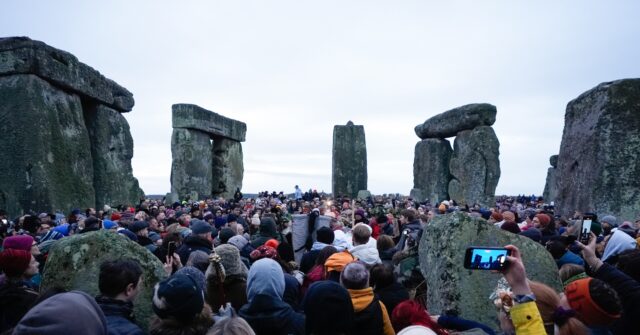On the winter solstice, a significant event unfolded at the ancient Stonehenge monument as thousands gathered to mark the dawn of the shortest day of the year. This annual celebration saw tourists, pagans, druids, and other enthusiasts come together at 8:09 a.m. GMT to witness the sunrise over the iconic standing stones. Despite the low winter clouds obscuring the sun, the atmosphere remained vibrant, filled with drumming, chanting, and singing, reflecting the collective anticipation and joy of the participants. The winter solstice, occurring around December 21 each year, is notable for being the longest night and the shortest day in the Northern Hemisphere, signaling a turning point where daylight gradually extends until the summer solstice in June.
Stonehenge holds a unique place in the hearts of many, especially during the solstices when visitors are permitted to approach the stones closely. This occasion draws a diverse mix of individuals who witness the ancient ritualistic practices that signify renewal and rebirth. As civil servant Chris Smith articulated, the event evokes feelings of energy and unity among the crowd, highlighting the shared human experience of transformation and reflection as they usher in a new year while acknowledging the past. Such gatherings foster a sense of community, underscoring the timeless significance of Stonehenge as a gathering place that transcends millennia.
Dating back approximately 5,000 years, Stonehenge was constructed by a sun-worshiping Neolithic culture, though its exact purpose remains a topic of ongoing scholarly debate. Research outlines various theories, proposing that the stone circle may have functioned as a temple, a solar observatory, a burial ground, or perhaps a combination thereof. This multifaceted aspect of Stonehenge contributes to its allure, inviting both historians and spiritual seekers to explore its mysteries. The annual observance of the solstice at the site echoes these diverse interpretations, allowing modern celebrants to connect with ancient traditions and the celestial movements that still resonate today.
Recent archaeological investigations have revealed new insights into the significance of Stonehenge, suggesting that it may have held not only spiritual but also political importance. Scholars from University College London and Aberystwyth University posited that the geographical origins of the stones indicate a unifying element among diverse populations across Britain. The discovery that the “altar stone,” a central feature of the monument, originated from Scotland, along with other stones brought from as far as the Preseli Hills in Wales, reinforces the idea that Stonehenge served as a monument celebrating connections among various groups, their ancestors, and the cosmos.
According to lead researcher Mike Parker Pearson, Stonehenge’s construction and the transportation of its stones across considerable distances possibly symbolize an ancient effort to forge a collective identity among different tribes. This perspective not only enriches our understanding of the monument’s role in Neolithic society but also gestures to a broader narrative of cooperation and shared heritage among the peoples of Britain. Such revelations speak to the profound aspirations of those who engaged in the monumental work, as they sought to create a lasting legacy that would endure through generations.
As the festivities at Stonehenge unfolded this winter solstice, the gathering undeniably encapsulated the enduring human desire for connection, reflection, and renewal amid the natural cycles of life. The celebration highlighted how ancient practices continue to inspire contemporary culture, fostering a sense of reverence for history while simultaneously encouraging a collective outlook towards the future. The spirit of togetherness observed during this moment serves as a poignant reminder of the shared experiences that bind us to each other and to our past, as illuminated beneath the ancient stones that have witnessed countless sunrises over the millennia.

